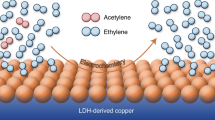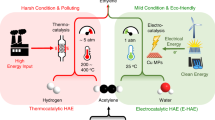Abstract
Variation in the selectivity of ethylene produced by acetylene hydrogenation in an integral reactor was analyzed as a function of the hydrogen/acetylene ratio in the reaction stream at the reactor inlet. The analyses were made for two sample catalysts, which showed different dependence of the ethylene selectivity on the reactant composition. Even a small mismatch between the hydrogen/acetylene ratio at the reactor inlet and the ratio for converted reactants caused a large change in the ethylene selectivity along the reactor position, particularly when the conversion was high. The results of this study indicate two important factors to be considered in the design and operation of acetylene hydrogenation process: the hydrogen/acetylene ratio in the reactor inlet should be controlled close to the ratio for converted reactants; and catalysts showing high ethylene selectivity over a wide range of the hydrogen/ acetylene ratio are required for the design of a highly selective hydrogenation process.
Similar content being viewed by others
References
Battiston, G. C., Dalloro, L. and Tauszik, G. R., “Performance and Aging of Catalysts for the Selective Hydrogenation of Acetylene: A Micropilot-Plant Study,”Appl. Catal.,2, 1 (1982).
Cider, L. and Schoon, N.H., “Hydrogenation of Acetylene at Trasient Conditions in the Presence of Olefins and Carbon Monoxide over Palladium/Alumina,”Ind. Eng. Chem. Res.,30, 1437 (1991).
Huang, W., “Optimize Acetylene Removal,”Hydrocarbon Processing,59(10), 131 (1979).
Lam, W. K. and Lloyd, L., “Catalyst Aids Selective Hydrogenation of Acetylene,”The Oil and Gas Journal,27, 66 (1972).
Lee, D. K., “Green-oil Formation and Selectivity Change in Selective Hydrogenation on Titania-Supported and Unsupported Palladium Catalysts for Acetylene Removal from Ethylene-rich Stream,”Korean J. Chem. Eng.,7, 233 (1990).
Leviness, S., Nair, V., Weiss, A.H., Schay, Z. and Cuczi, L., “Acetylene Hydrogenation Selectivity Control on PdCu/Al2O3 Catalysts,”J. Mol. Catal.,25, 131 (1984).
Park, Y.H. and Price, G. L., “Deuterium Tracer Study on the Effect of CO on the Selective Hydrogenation of Acetylene over Pd/Al2O3,”Ind. Eng. Chem. Res.,30, 1693 (1991).
Shin, E.W., Choi, C.H., Chang, K. S., Na, Y.H. and Moon, S.H., “Properties of Si-modified Pd Catalyst for Selective Hydrogenation of Acetylene,”Catal. Today,44, 137 (1998).
Shin, E.W., Cho, S. I., Kang, J.H., Kim, W. J., Park, J.D. and Moon, S.H., “Palladium-Hydrogen Interaction on Supported Palladium Catalysts of Different Metal Dispersions,”Korean J. Chem. Eng.,17, 468 (2000).
Shin, E.W., Kang, J. H., Kim, W. J., Park, J.D. and Moon, S.H., “Performance of Si-modified Pd Catalyst in Acetylene Hydrogenation: The Origin of the Ethylene Selectivity Improvement,”Applied Catalysis A: General,223, 161 (2002).
Author information
Authors and Affiliations
Corresponding author
Additional information
This paper is dedicated to Professor Wha Young Lee on the occasion
Rights and permissions
About this article
Cite this article
Kim, W.J., Choi, C.H. & Moon, S.H. Ethylene selectivity variation in acetylene hydrogenation reactor with the hydrogen/acetylene ratio at the reactor inlet. Korean J. Chem. Eng. 19, 617–621 (2002). https://doi.org/10.1007/BF02699306
Received:
Accepted:
Issue Date:
DOI: https://doi.org/10.1007/BF02699306




